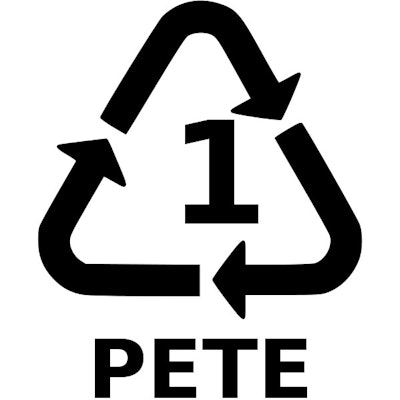
The Association of Postconsumer Plastic Recyclers (APR) and the National Association for PET Container Resources (NAPCOR) are expressing growing concern about what they feel is the misuse of the Resin Identification Code. Although use of the code, created in 1988 by the Society of the Plastics Industry (SPI) for all rigid plastic packaging, is mandated by varying laws in 39 states, it is nonetheless the de facto national standard, they report.
Says Steve Alexander, executive director of APR, “Misuse of the code is an extremely serious issue for plastics reclaimers. We see bottles labeled with such terms as ‘Compatible with PET Recycling’ and wonder what that undefined phrase means. We also see bottles that are clearly not made from PET resin being labelled as ‘#1 PETE.’ These rogue bottles can have a draconian impact on the plastics reclamation process. Many of these rogues have such low melting points that inclusion with PET bottles can shut down recycling operations.”
Says NAPCOR executive director Dennis Sabourin, “The SPI Code has long been used as a tool for recycling program officials to educate consumers as to what plastic packaging is being collected for recycling. The code has been largely self-policing and, until recent years, this has been successful. While designed to indicate package resin, it is effectively the national standard for the labeling of plastic packaging for recycling purposes. Misuse and mislabeling of a package is a significant problem for reclaiming that category of packaging, and ultimately will cause considerable disruption in the markets for recycled plastic materials.”
A primary concern is that a material that is mislabeled will be combined with material that is properly labeled, thereby contaminating the entire bale of properly labeled material. Long term, code misuse will cause major disruptions in the marketing and handling of recycled plastic materials, say APR and NAPCOR. Buyers and sellers of plastic materials rely on accurate labeling of bottles. If reclaimers cannot be assured that they are truly buying a bale of just PET, high-density polyethylene, or other resin, then the buying of that material will likely cease. Given today’s economic climate, such contamination, if not addressed, will have significant implications for plastics recycling, the associations believe.
Adds Sabourin, “While the resin identification laws differ state to state, most, but not all, states have demonstrated that they will accept the coding of a ‘non conforming’ package according to its compatibility within a particular recycling stream. Unfortunately, only Kentucky has set standards for recycling compatibility. Further, the financial implications of recycling compatibility are magnified when viewed in the context of Extended Producer Responsibility programs where fees are based on the cost of recycling a given stream of material.”
Alexander, whose APR members represent more than 94% of the post-consumer plastic reclamation capacity in North America, called on brand owners to continue to work with the association to address, on a scientific basis, issues concerning the appropriate criteria for coding PET and HDPE bottles. These bottles form the major plastic recycling streams of its members.

























